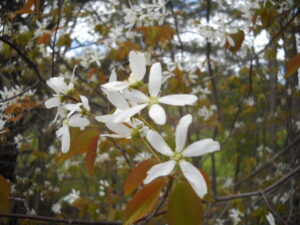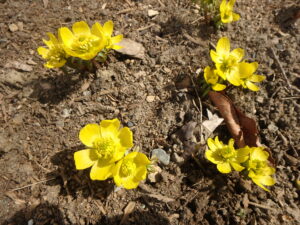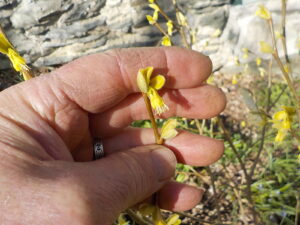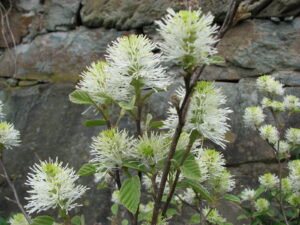Spring Flowers I Love
Posted on Tuesday, May 3, 2022 · Leave a Comment

Shadbush in bloom
Spring has teased us this year: she comes, she goes; warm sunny days are followed by high winds, cold rain and even pellets of ice. But the spring flowers persist, starting with those dainty white snowdrops that appear reliably in early March for me. Let’s look at a few – bulbs, shrubs and trees. Perennials I will do on another day.
Snowdrops (Galanthus spp.) bloom with white blossoms on short stems in early March, but seem a bit depressed, I think. They always turn their faces down to the ground. I have some “double” snowdrops that really are gorgeous, but I only see their extra petals when I bend down and turn their faces up. Probably not worth a dollar a bulb, which is what they cost. Snowdrops tend to naturalize, becoming more numerous each year and moving out from flower beds and into the lawn.
After the snowdrops come Glory of the Snow (Chionodoxa luciliae). These are cheerful blue, pink or white flowers that look up to look at me. Sometimes I think they wink at me, saying, “Hey dude, look at us. We are spring.” I mainly grow the blue ones. These naturalize well, spreading quickly.
Related to Glory of the Snow, but more intense in color and attitude, come Siberian squill, most commonly referred to by their scientific name, Scilla (Scilla siberica). They are a deep purple, and their faces point down, looking at their sneakers.

Winter acconite blooms about the same time as snow drops
Along with those flowers come a bright yellow one, Winter Aconite (Eranthis hyemalis). These are low-growing, upward facing flowers with 5 to 8 petals (actually sepals, but who cares?). Like the others, they tend to spread and increase in number. Order some now, along with the others mentioned, and plant them in the fall.
You know crocus, but you might not know that there are 80 or more distinct species of crocus. Some are very early, others bigger and later. Go on line and look at all the varieties. These are good for early pollinators hungry for pollen and nectar.
Daffodils are mildly poisonous to rodents and deer, so they avoid them. Mine are now in full bloom. There are 13 classes of daffies, each quite distinct. Tulips are flavor treats for deer, and rodents love the bulbs. So maybe you should grow them as potted flowers. Or take your chances. Having a several cats will help tulip bulbs survive, and a dog will keep the deer away. My favorite is ‘Maureen’, a 24 to 28-inche tall late bloomer, but I love them all!
Most trees do not have showy blossoms. Why not? Most are wind-pollinated, so do not need to attract pollinators with flashy blossoms or great fragrances. You might never have noticed the blossoms of pines or oaks or maples. Actually, you must have seen red maples (Acer rubrum) bloom. They are early, one of the first trees to blossom. The blossoms are small and fuzzy in appearance. But there are so many blooming at once, you will notice them if you hike in the woods in April.
But of the showy trees, the best in my opinion, is a hybrid magnolia called ‘Merrill’ or ‘Dr. Merrill’ (Magnolia x loebneri ‘Merrill’) named after the Director of the Arnold Arboretum at Harvard in 1952, but actually bred by Karl Sax. It blooms reliably for me in the last week of April and into May. The blossoms are double, fragrant, and 2 to 3-inch across.

Leatherwood blossoms
This week my leatherwood bush (Dirca palustris) is in bloom with heart-stopping beauty. It is a small native shrub that blooms in dry shade for me. It has lovely gray bark much like beech trees and yellow blossoms that appear before the leaves. The blossoms are small and elegant, and almost seem to glow. It is not a common shrub for sale in nurseries. Mine has upward growing branches in a vase-shaped arrangement. I love it and visit every day when in bloom.
Then there is February Daphne. Well, maybe it blooms in New Jersey or Virginia in February, but it blooms in April for me. It has lots of small pink-purplish stemless blossoms up its branches. It is highly fragrant. It is only 3- to 5-feet tall and wide, and rarely needs pruning. It is native to Europe and Asia, not here, and is said to spread by seed distributed by birds. But in 20 years I have never seen a volunteer on my property. Some people react poorly to the sap, and the berries are toxic if eaten by humans. It likes a part sun-part shade spot.

Fothergilla major blooms in May
Perhaps a better shrub to choose would be a fothergilla, which is native and early. There are 2 species, Fothergilla major and F. gardenia, also known as dwarf fothergilla. It has wonderful white bottlebrush flowers in May and best of all, it has fabulous fall foliage color. Red, orange, purple and yellow leaves on one plant! It is not a fast growing plant, and rarely needs pruning.
Another early bloomer and a great producer of berries for birds is small tree or large shrub called shadbush, serviceberry or by its scientific name, Amelanchier spp. I see them blooming along the roadsides in May, nice small white blossoms that remind me of wild apple blossoms. It has nice gray bark, and they often grow as multi-stemmed plants. I have a few, but the fruit is eaten by birds before I ever get to it.






